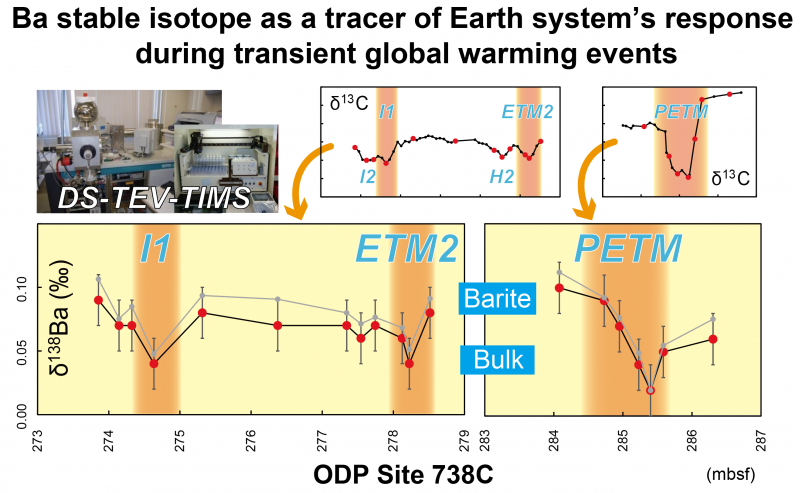
Ba stable isotope excursions induced by multiple hyperthermal events: A potential new index for transient global warming
ABSTRACT

During the early Paleogene (59–50 Ma), several short-term global warming events, known as hyperthermal events, occurred. Negative carbon isotope (δ13C) excursions are a typical proxy for detecting hyperthermal events. During the recovery from hyperthermal events, δ13C values returned toward pre-event levels via scavenging lighter C isotopes from the ocean and sequestrating them within sediments. The biological pump plays a key role in this process. Barium (Ba) is a nutrient-type element primarily transported in the water column by barite formed in microenvironments associated with the decomposition of organic matter, and the Ba-stable isotope ratio is a proxy of biological productivity. In this study, the δ138/134Ba values of bulk sediment samples from Ocean Drilling Program Site 738C in the southern part of the Kerguelen–Heard Plateau were analyzed. Although the samples predominantly comprised calcareous chalk corresponding to the latest Paleocene to early Eocene (56–52 Ma), the Ba isotope ratios of the bulk samples reflected a barite mixture with slight carbonate. Three negative δ138/134Ba shifts were detected, corresponding to the global super-warming event “Paleocene–Eocene Thermal Maximum” at 56 Ma and to two hyperthermal events, known as ETM2 and I1. The changes in δ138/134Ba and δ13C values during PETM were comparable to those reported from the South Atlantic Ocean. Although commonly recognized, the scale of δ138/134Ba changes was smaller in the modest hyperthermal events (ETM2 and I1). Ba stable isotope ratios are a highly effective and powerful tool to reveal the response of the surficial system of Earth during hyperthermal events.
KEYWORDS
Keywords: Ba stable isotope ratio, Ocean Drilling Program Site 738C, Paleocene–Eocene Thermal Maximum, carbon isotope excursion, biological pump- Published : 2023
- Released on J-STAGE : 2023/08/08
- Received : 2023/01/16
- Accepted : 2023/06/10
- DOI : https://doi.org/10.2343/geochemj.GJ23011
- J-STAGE URL : https://www.jstage.jst.go.jp/article/geochemj/57/4/57_GJ23011/_article/-char/en
- J-Online ISSN: 1880-5973
- Print ISSN : 0016-7002
- ISSN-L : 0016-7002
All Issues
- Vol.59, 2025
- Vol.58, 2024
- Vol.57, 2023
- Vol.56, 2022
- Vol.55, 2021
- Vol.54, 2020
- Vol.53, 2019
- Vol.52, 2018
- Vol.51, 2017
- Vol.50, 2016
- Vol.49, 2015
- Vol.48, 2014
- Vol.47, 2013
- Vol.46, 2012
- Vol.45, 2011
- Vol.44, 2010
- Vol.43, 2009
- Vol.42, 2008
- Vol.41, 2007
- Vol.40, 2006
- Vol.39, 2005
- Vol.38, 2004
- Vol.37, 2003
- Vol.36, 2002
- Vol.35, 2001
- Vol.34, 2000
- Vol.33, 1999
- Vol.32, 1998
- Vol.31, 1997
- Vol.30, 1996
- Vol.29, 1995
- Vol.28, 1994
- Vol.27, 1993
- Vol.26, 1992
- Vol.25, 1991
- Vol.24, 1990
- Vol.23, 1989
- Vol.22, 1988
- Vol.21, 1987
- Vol.20, 1986
- Vol.19, 1985-1986
- Vol.18, 1984
- Vol.17, 1983
- Vol.16, 1982
- Vol.15, 1981
- Vol.14, 1980
- Vol.13, 1979
- Vol.12, 1978
- Vol.11, 1977
- Vol.10, 1976
- Vol.9, 1975
- Vol.8, 1974
- Vol.7, 1973
- Vol.6, 1972-1973
- Vol.5, 1971
- Vol.4, 1970-1971
- Vol.3, 1969-1970
- Vol.2, 1968
- Vol.1, 1966-1967




